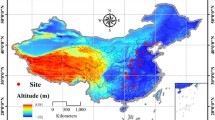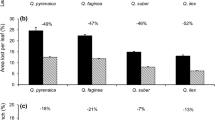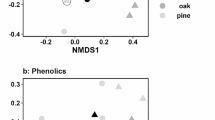Abstract
Ecologists are interested in consequences of changes in the timing of ecological interactions because of the potential for widespread phenological shifts under climate change. Plant–herbivore interactions may be particularly affected by phenology changes if they result in differences in leaf defensive chemistry and other aspects of host foliage quality. Recent studies of defensive leaf phenolics have focused on their ability to create oxidative stress in herbivores, but the phenology of this “oxidative capacity,” including seasonal patterns and how it is affected by leaf-out phenology, is unknown. We combined observational and experimental studies of oaks (Quercus spp.) to determine if leaf-out phenology correlates with oxidative capacity and leaf characteristics, herbivore abundance, and leaf damage, and how oxidative capacity changes through spring and summer leaf development. Oaks with earlier leaf-out had significantly lower oxidative capacity in spring and early summer, and there was a trend for higher spring leaf damage on these trees. One group of spring herbivores, leaf rollers, was more abundant on earlier-leafing trees. By mid-summer, leaf quality differences disappeared. Repeated measurements of individual trees demonstrated that oxidative capacity is highest shortly after leaf-out but declines within 2 weeks. These results partially contrast traditional views of leaf defense phenology where leaves are most susceptible shortly after leaf-out, but defenses build as proanthocyanidins accumulate in expanded leaves. Early season oxidative defenses may have a significant effect on plant growth by protecting young leaves at a time when leaf tissue loss will have the greatest consequences for later photosynthesis.




Similar content being viewed by others
References
Appel HM (1993) Phenolics in ecological interactions: the importance of oxidation. J Chem Ecol 19:1521–1552
Augspurger CK, Cheeseman JM, Salk CF (2005) Light gains and physiological capacity of understorey woody plants during phenological avoidance of canopy shade. Funct Ecol 19:537–546. doi:10.1111/j.1365-2435.2005.01027.x
Barbehenn RV, Jones CP, Hagerman AE et al (2006a) Ellagitannins have greater oxidative activities than condensed tannins and galloyl glucoses at high pH: potential impact on caterpillars. J Chem Ecol 32:2253–2267
Barbehenn RV, Jones CP, Karonen M, Salminen J-P (2006b) Tannin composition affects the oxidative activities of tree leaves. J Chem Ecol 32:2235–2251
Barber NA, Marquis RJ (2009) Spatial variation in top-down direct and indirect effects on white oak (Quercus alba L.). Am Midl Nat 162:169–179
Barber NA, Marquis RJ (2010) Light environment and the impacts of foliage quality on herbivorous insect attack and bird predation. Oecologia 166:401–409. doi:10.1007/s00442-010-1840-9
Barber N, Marquis R (2011) Leaf quality, predators, and stochastic processes in the assembly of a diverse herbivore community. Ecology 92:699–708. doi:10.1890/10-0125.1
Barbosa P, Krischik V, Lance D (1989) Life-history traits of forest-inhabiting flightless Lepidoptera. Am Midl Nat 122:262–274. doi:10.2307/2425912
Bolker BM, Brooks ME, Clark CJ et al (2009) Generalized linear mixed models: a practical guide for ecology and evolution. Trends Ecol Evol 24:127–135. doi:10.1016/j.tree.2008.10.008
Buse A, Good JEG, Dury S, Perrins CM (1998) Effects of elevated temperature and carbon dioxide on the nutritional quality of leaves of oak (Quercus robur L.) as food for the winter moth (Operophtera brumata L.). Funct Ecol 12:742–749. doi:10.1046/j.1365-2435.1998.00243.x
Charney N, Eiseman C (2010) Tracks & sign of insects and other invertebrates: a guide to North American species, 1st edn. Stackpole Books, Mechanicsburg
Chen Z, Kolb TE, Clancy KM (2001) Mechanisms of Douglas-fir resistance to western spruce budworm defoliation: bud burst phenology, photosynthetic compensation and growth rate. Tree Physiol 21:1159–1169
Cleland EE, Chuine I, Menzel A et al (2007) Shifting plant phenology in response to global change. Trends Ecol Evol 22:357–365
Coley PD, Barone JA (1996) Herbivory and plant defenses in tropical forests. Annu Rev Ecol Syst 27:305–335
Connor EF, Adams-Manson RH, Carr TG, Beck MW (1994) The effects of host plant phenology on the demography and population dynamics of the leaf-mining moth, Cameraria hamadryadella (Lepidoptera: Gracillariidae). Ecol Entomol 19:111–120. doi:10.1111/j.1365-2311.1994.tb00400.x
Crawley MJ, Akhteruzzaman M (1988) Individual variation in the phenology of oak trees and its consequences for herbivorous insects. Funct Ecol 2:409–415
Dudt JF, Shure DJ (1994) The influence of light and nutrients on foliar phenolics and insect herbivory. Ecology 75:86–98
Dury SJ, Good JEG, Perrins CM et al (1998) The effects of increasing CO2 and temperature on oak leaf palatability and the implications for herbivorous insects. Glob Change Biol 4:55–61. doi:10.1046/j.1365-2486.1998.00102.x
Faeth SH (1985) Quantitative defense theory and patterns of feeding by oak insects. Oecologia 68:34–40
Feeny P (1970) Seasonal changes in oak leaf tannins and nutrients as a cause of spring feeding by winter moth caterpillars. Ecology 51:565–581
Forkner RE, Marquis RJ, Lill JT (2004) Feeny revisited: condensed tannins as anti-herbivore defences in leaf-chewing herbivore communities of Quercus. Ecol Entomol 29:174–187
Forkner RE, Marquis RJ, Lill JT, Le Corff J (2008) Timing is everything? phenological synchrony and population variability in leaf-chewing herbivores of Quercus. Ecol Entomol 33:276–285. doi:10.1111/j.1365-2311.2007.00976.x
Hayhoe K, VanDorn J, Croley T II et al (2010) Regional climate change projections for Chicago and the US Great Lakes. J Gt Lakes Res 36(2):7–21. doi:10.1016/j.jglr.2010.03.012
Hothorn T, Bretz F, Westfall P (2008) Simultaneous inference in general parametric models. Biom J 50:346–363
Hunter MD (1992) A variable insect–plant interaction: the relationship between tree budburst phenology and population levels of insect herbivores among trees. Ecol Entomol 17:91–95. doi:10.1111/j.1365-2311.1992.tb01046.x
Hunter AF, Elkinton JS (2000) Effects of synchrony with host plant on population dynamics of a spring-feeding Lepidopteran. Ecology 81:1248–1261
Hunter AF, Elkinton JS (2001) Interaction between phenology and density effects on mortality from natural enemies. J Anim Ecol 68:1093–1100
Hunter AF, Lechowicz MJ (1992) Foliage quality changes during canopy development of some northern hardwood trees. Oecologia 89:316–323. doi:10.1007/BF00317408
Jeong S-J, Ho C-H, Gim H-J, Brown ME (2011) Phenology shifts at start vs. end of growing season in temperate vegetation over the Northern Hemisphere for the period 1982–2008. Glob Change Biol 17:2385–2399
Kwit MC, Rigg LS, Goldblum D (2010) Sugar maple seedling carbon assimilation at the northern limit of its range: the importance of seasonal light. Can J For Res 40:385–393
Lill JT, Marquis RJ (2003) Ecosystem engineering by caterpillars increases insect herbivore diversity on white oak. Ecology 84:682–690
Liu Y, Reich PB, Li G, Sun S (2011) Shifting phenology and abundance under experimental warming alters trophic relationships and plant reproductive capacity. Ecology 92:1201–1207
Makkar HPS, Dawra RK, Singh B (1991) Tannin levels in leaves of some oak species at different stages of maturity. J Sci Food Agric 54:513–519. doi:10.1002/jsfa.2740540403
Marino PC, Cornell HV (1993) Adult feeding and oviposition of Phytomyza ilicicola (Diptera: Agromyzidae) in response to leaf and tree phenology. Environ Entomol 22:1294–1301
Marquis RJ, Whelan CJ (1994) Insectivorous birds increase growth of white oak through consumption of leaf-chewing insects. Ecology 75:2007–2014
Mattson WJ, Scriber JM (1987) Nutritional ecology of insect folivores of woody plants: nitrogen, water fiber and mineral considerations. In: Slansky F, Rodriquez JG (Eds) Nutr. Ecol. Insects Mites Spiders. Wiley, New York, pp 105–146
Memmott J, Craze PG, Waser NM, Price MV (2007) Global warming and the disruption of plant–pollinator interactions. Ecol Lett 10:710–717. doi:10.1111/j.1461-0248.2007.01061.x
Mopper S, Simberloff D (1995) Differential herbivory in an oak population: the role of plant phenology and insect performance. Ecology 76:1233–1241
Murakami M, Yoshida K, Hara H, Toda MJ (2005) Spatio-temporal variation in Lepidopteran larval assemblages associated with oak, Quercus crispula: the importance of leaf quality. Ecol Entomol 30:521–531
Nichols-Orians CM (1991) Environmentally induced differences in plant traits: consequences for susceptibility to a leaf-cutter ant. Ecology 72:1609–1623
Parmesan C (2006) Ecological and evolutionary responses to recent climate change. Annu Rev Ecol Evol Syst 37:637–669
Parmesan C (2007) Influences of species, latitudes and methodologies on estimates of phenological response to global warming. Glob Change Biol 13:1860–1872
Parmesan C, Yohe G (2003) A globally coherent fingerprint of climate change impacts across natural systems. Nature 421:37–42
Pinheiro J, Bates D, DebRoy S, Sarkar D (2010) nlme: linear and nonlinear mixed effects models. R package version 3.1-97
Polgar CA, Primack RB (2011) Leaf-out phenology of temperate woody plants: from trees to ecosystems. New Phytol 191:926–941. doi:10.1111/j.1469-8137.2011.03803.x
R Development Core Team (2013) R: A language and environment for statistical computing. R Foundation for Statistical Computing, Vienna, Austria. ISBN 3-900051-07-0. http://www.R-project.org/
Salminen JP, Karonen M (2011) Chemical ecology of tannins and other phenolics: we need a change in approach. Funct Ecol 25:325–338
Salminen J-P, Roslin T, Karonen M et al (2004) Seasonal variation in the content of hydrolyzable tannins, flavonoid glycosides, and proanthocyanidins in oak leaves. J Chem Ecol 30:1693–1711
Schwartz MD, Ahas R, Aasa A (2006) Onset of spring starting earlier across the Northern Hemisphere. Glob Change Biol 12:343–351
Stoepler TM, Rehill B (2012) Forest habitat, not leaf phenotype, predicts late-season folivory of Quercus alba saplings. Funct, Ecol
Thackeray SJ, Sparks TH, Frederiksen M et al (2010) Trophic level asynchrony in rates of phenological change for marine, freshwater and terrestrial environments. Glob Change Biol 16:3304–3313
Tikkanen O-P, Julkunen-Tiitto R (2003) Phenological variation as protection against defoliating insects: the case of Quercus robur and Operophtera brumata. Oecologia 136:244–251. doi:10.1007/s00442-003-1267-7
Valtonen A, Ayres MP, Roininen H et al (2011) Environmental controls on the phenology of moths: predicting plasticity and constraint under climate change. Oecologia 165:237–248
Van Asch M, Visser ME (2007) Phenology of forest caterpillars and their host trees: the importance of synchrony. Annu Rev Entomol 52:37–55
Van Asch M, Tienderen V, Peter H et al (2007) Predicting adaptation of phenology in response to climate change, an insect herbivore example. Glob Change Biol 13:1596–1604
Van Dongen S, Backeljau T, Matthysen E, Dhondt AA (1997) Synchronization of hatching date with budburst of individual host trees (Quercus robur) in the winter moth (Operophtera brumata) and its fitness consequences. J Anim Ecol 66:113–121. doi:10.2307/5969
Visser ME, Holleman LJM (2001) Warmer springs disrupt the synchrony of oak and winter moth phenology. Proc R Soc Lond B Biol Sci 268:289–294. doi:10.1098/rspb.2000.1363
Westfall PH (1997) Multiple testing of general contrasts using logical constraints and correlations. J Am Stat Assoc 92:299–306. doi:10.2307/2291474
Acknowledgments
We are indebted to E. Justus, M. Minton, L. Gordon, and B. Bash for field and laboratory assistance. This research benefited from cooperation with the Morton Arboretum, DeKalb County Forest Preserve District, and McHenry County Nursery, Inc. Funding was provided by Northern Illinois University and the NIU Office of Student Engagement and Experiential Learning.
Conflict of interest
The authors declare no conflicts of interest.
Author information
Authors and Affiliations
Corresponding author
Additional information
Handling Editor: Kerstin Reifenrath.
Rights and permissions
About this article
Cite this article
Barber, N.A., Fahey, R.T. Consequences of phenology variation and oxidative defenses in Quercus . Chemoecology 25, 261–270 (2015). https://doi.org/10.1007/s00049-015-0194-5
Received:
Accepted:
Published:
Issue Date:
DOI: https://doi.org/10.1007/s00049-015-0194-5




